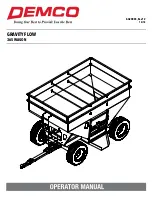
AG20003
Page 7
• When halting operation, even periodically, set tractor or towing vehicles brakes, disengage PTO, shut off
engine, and
remove ignition key
.
• Be especially observant of operating area and terrain. Watch for holes, rocks, or other hidden hazards. Always
inspect area prior to operation.
- DO NOT operate near edge of drop-off or banks.
- DO NOT operate on steep slopes as overturn may result.
- Operate up and down (not across) intermediate slopes. Avoid sudden starts and stops.
• Pick the most level possible route when transporting across fields. Avoid edges of ditches, gullies, and steep
hillsides.
• Be extra careful when working on inclines.
• Maneuver tractor or towing vehicle at safe speeds.
• Avoid overhead wires or other obstacles. Contact with overhead lines could cause serious injury or death.
• Avoid loose gravel, rocks, and holes; they can be dangerous for equipment operation or movement.
• Allow for unit length when making turns.
• Do not walk or work under raised components or attachments unless securely positioned and blocked.
• Keep all bystanders, pets, and livestock clear of work area.
• Operate towing vehicle from operators seat only.
• Never stand alongside of unit with engine running or attempt to start engine and/or operate machine while
standing alongside of unit.
• Never leave running equipment unattended.
• As a precaution, always recheck hardware on equipment following every 100 hours of operation. Correct all
problems. Follow maintenance safety procedures.
FollowiNG oPERAtioN
• Following operation, or when unhitching, stop tractor or towing vehicle, set brakes, shut off engine and
remove
ignition key
.
• Store unit in an area away from human activity.
• Do not park equipment where it will be exposed to livestock for long periods of time. Damage and livestock
injury could result.
• Do not permit children to play on or around stored unit.
• Make sure all parked machines are on a hard, level surface and engage all safety devices.
• Wheel chocks may be needed to prevent unit from rolling.
hiGhwAy AND tRANSPoRt oPERAtioNS
•
SAFETY CHAINS:
If equipment is going to be transported on a public highway, always follow state and local
regulations regarding safety chains and auxiliary lighting. Be sure to check with local law enforcement agen-
cies for your own particular regulations. Only safety chains (not elastic or nylon/plastic tow straps) should be
used to retain connection between towing and towed machines in event of separation of primary attaching
system. Use a high strength, appropriately sized hitch pin with a mechanical retainer and attach safety chains.
Criss cross chains under tongue and secure to draw bar cage, mounting loops, or bumper frame.
• Adopt safe driving practices:
-
Keep brake pedals latched together at all times.
NEVER USE INDEPENDENT BRAKING WITH
MACHINE IN TOW, LOSS OF CONTROL AND/OR UPSET OF UNIT CAN RESULT
.
- Always drive at a safe speed relative to local conditions, ensure that your speed is low enough for an
emergency stop. Keep speed to a minimum.
SAFEty
















